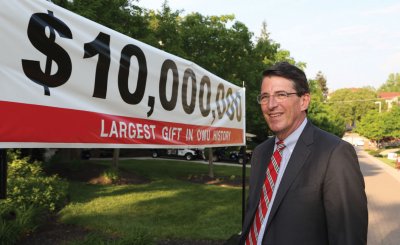OWU Magazine Contact Information
Location
Ohio Wesleyan University
61 S. Sandusky St.
Delaware, OH 43015
E magazine@owu.edu


 Whether it is going off to college, moving to a new community, or starting a new job, one of the first questions we often ask people is, where will you live? This question is especially important for students who enroll at a small, residential college like Ohio Wesleyan. Where will you live?
Whether it is going off to college, moving to a new community, or starting a new job, one of the first questions we often ask people is, where will you live? This question is especially important for students who enroll at a small, residential college like Ohio Wesleyan. Where will you live?
Over the past two years, we have taken a fresh look at the residential experience of our students and the needs of our residential campus. In February our Board of Trustees held a retreat devoted to the single topic of the residential experience of our students and the needs of our residential campus. At the conclusion of the retreat, the Board endorsed a bold five-year, $60 million investment in the residential campus. This plan, which will be funded by a combination of philanthropy, debt, and historic tax credits, represents the largest financial investment in Ohio Wesleyan history.
Why are residential facilities important? At Ohio Wesleyan, the entire campus is a laboratory for learning. Students spend more time in residence halls than any other single location on campus. In residence halls they form friendships, engage in vigorous debate over pressing issues of our day, share with one another their greatest aspirations and their most profound challenges, and form the sense of community that defines the OWU experience.
This investment will offer students a residential experience that provides increasing independence through their college years.
At a time when some wonder if education is best and most efficiently offered online from the comfort of one’s own home, we believe that going to college still matters, and that a part of going to college is the experience of total immersion that accompanies living in residence with a diverse group of women and men from all over the world, from every walk of life, and with an extraordinary range of life experiences and personal perspectives.
Over the past decade Ohio Wesleyan has invested more than $30 million in residential facilities, including the renovation of Stuyvesant Hall and three houses on the Hill, and construction of Sloan House, Dicke House, Dittrick House (all Small Living Units), Gillespie Honors House and Butler A. Jones House of Black Culture.
These additions are significant, but they represent only 25 percent of the beds on campus. All of the remaining campus residential facilities are buildings constructed in the 1950s and ’60s. The buildings have fallen into significant disrepair, are too often unsightly, and recently have become a significant detractor in our ability to recruit new students. This investment is essential to our ability to attract the best student body in the future.
How will the residential experience change?
This investment will offer students a residential experience that provides increasing independence through their college years.
Smith Hall, our largest building and home to the residential campus dining hall, will be fully renovated as a center for first-year students. It will have design features that encourage students to engage with one another and develop a strong sense of community as they begin their college experience.
Renovation of the remaining houses on the Hill reflects our commitment to Greek life.
Modest renovations to Welch and Hayes will complement the full renovation of Stuyvesant Hall and our recent new construction to provide sophomores and juniors a variety of residential experiences in suites or small communities.
The Village, a quadrangle of apartment buildings, will offer seniors privacy and the opportunity to live independently in preparation for life after college. Over four years students will benefit from a residential experience that progresses from the interactive community of a first-year center to the privacy of a senior experience.
At the February retreat, as the Board of Trustees contemplated this vision and the financial challenge it presented, Board chair John Milligan ’83 and his wife, Kathie ’83, announced their commitment of $5 million toward the $20 million philanthropic objective. Their classmate, Kara Trott ’83, announced a $2.2 million commitment. Since February, we have secured commitments totaling more than $15 million for this initiative.
These announcements were followed in May by the news of the single largest outright gift in Ohio Wesleyan history, a $10 million anonymous gift from an alumni couple who met at OWU. The gift supports renovation of historic Slocum Hall and of the residential campus, making a strong statement about the importance of the physical campus to an OWU education. This announcement capped a fundraising year that exceeded $45 million, more than $14 million larger than the previous high in this campaign.
In this issue of OWU Magazine, you will read more about the Residential Campus Renewal Plan, and you will read more about the remarkable success of the Connect Today, Create Tomorrow campaign in support of this plan and other important strategic initiatives. While the residential campus is critical to the recruitment and retention of students, it is even more important as a laboratory of learning that supports our work to educate the next generation of moral leaders for a global society.
When I watched our seniors take their place at commencement in May, I saw again how this mission has been fulfilled in extraordinary ways. When I see the philanthropic support of so many alumni and friends in a record-breaking fundraising year, I am confident that OWU has the resources and vision to sustain this mission in the lives of students yet to arrive on campus.
Thank you for your generous support and for your abiding passion for Ohio Wesleyan. Your passion and generosity change lives on this campus, every day.
![]()
Rock Jones
President, Ohio Wesleyan University
Twitter: @owu_rockjones